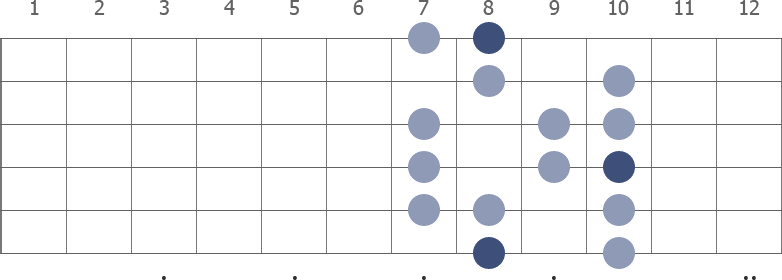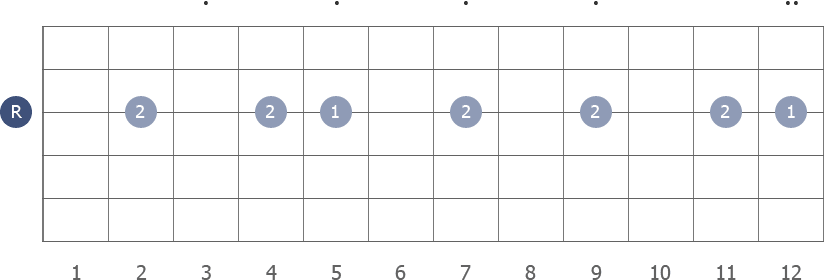FAQ
Questions and answers regarding content on this site.
Click on a tab for information.
The circles indicate positions on the fingerboard for tones in the specific scale (circles with darker color represent root notes, the first note in the scale and more correctly named the tonic). The numbers above the diagram indicate the frets.
The horizontal lines are representations of the strings. From lowest to the highest string, these are E, A, D, G, B and e. The vertical lines are representations of the frets, including the nut as the thicker line.
And lastly, the dots on the bottom represent the typical configuration of fret inlays on the guitar fingerboard.

The picture is a schematic representation of a fingerboard. The purpose is not to create a realistic representation in a graphical sense, but a conception by which the needed information quickly can be identified.
You may encounter, especially in books, symbols such as squares and triangles. These are standardized symbols in black and white presentations, but when color is an option, this way of distinction is no longer demanded. Moreover, Guitarscale.org uses additional color codes in some specific situation for educational purposes.
Notes refer to pitches, which are distinguished by the variation of sound waves.
In Western music, there are 12 unique pitches and in total 17 names of notes. The names of the notes are:
- C
- C# (C sharp)
- D
- Db (D flat)
- D# (D sharp)
- E
- Eb (E flat)
- F
- F# (F sharp)
- G
- Gb (G flat)
- G# (G sharp)
- A
- Ab (A flat)
- A# (A sharp)
- B
- Bb (B flat)
The reason behind the difference of unique pitches and names is due to the circumstance that five of the pitches has two names. C# and Db are actually the same tone from a pitch perspective. The names are interchangeable depending on the musical context.
The note names “B#”, “Cb”, “E#” or “Fb” turns up among listed notes. These are all theoretical names for describing specific notes in some circumstances. “B#" is the same as C, “Cb” is the same as B, “E#” is the same as F and “Fb” is the same as E.
The reason behind it is a practice that dictate against including the same letter twice in scale notations. This becomes practical in sight reading, there a sharpened E, for instance, is needed to correctly interpret the notation.
When "##" and “bb” turns up among listed notes, it can be confusing for some that haven’t seen the use of this notation before. For example, C## (spelled C double sharp) is a theoretical way for describing D. Info about this on GuitarScale.org related to specific scales, can normally be seen under the "Scale degrees" tab.
The reason behind it is a practice that dictate against including the same letter twice in scale notations. This becomes practical in sight reading, there double sharps and double flats are needed in some situations in which notes otherwise couldn’t be interpreted.
The purpose of a scale formula is to explain how the scale is constructed based on intervals. This can be helpful information since all scales in a category share the same intervals.
The formula is described by steps, which are called semi-notes or steps. The Major scale can be described by these methods as follows:
- Semi-note intervals: 2 - 2 - 1 - 2 - 2 - 2 - 1
- Steps: Whole, whole, half, whole, whole, whole, half
In both cases, it starts from the root note (tonic) and continues to the next octave.
The diagram shows the G Major scale on one string and numbers indicating semi-note intervals:

The intervals of a scale can be described with half and whole steps. This is the same as one and two frets on the guitar fingerboard:
- Half step: one fret
- Whole step: two frets
- Whole and a half step: three frets
A degree is the place a tone has in a scale when counted forward from the root. A Major scale includes seven tones and can be written as one to seven.
Major scale degrees: 1 - 2 - 3 - 4 - 5 - 6 - 7
Degrees are sometimes written to include the next octave tone and is usually written with “R” as the first degree, signifying the root note.
A second way to write Major scale degrees: R - 2 - 3 - 4 - 5 - 6 - 7
A leading tone is a note that resolves to a note a half step higher or lower. In a scale context, the leading tone is the last tone in the scale and can function as a leading tone back to the tonic, one half step up.
In case of the C Major scale, B is the leading tone one step lower than the C tone in the next octave.
The root note is the note after which the scale (or chord) is named. For example, in the C Major scale, the note C is the root note. The root note is the first note in a scale. In a scale context, tonic is often the used term instead of root.
"Scale type" is in this case used to describe the scale based on how many notes it contains. Names such as pentatonic, septatonic and octatonic describe scales from this viewpoint. For example, septa- and
octa- are prefixes for seven and eight, respectively.
Pentatonic is a type of scale that contain five notes, but the name pentatonic is also especially associated with the two scales called Pentatonic Major and Pentatonic Minor. To summarize, pentatonic can both refer to a five-notes scale in general and specific scales.
There are numerous categories of scales, from the most fundamental to the very rare ones, and too many to list them all here. A large variety of the scales needed for a guitarist is presented on Guitarscale.org.
The two basics scales are the Major and Minor, which also include some variants. There are no specific scales such as Major 7th scale or Minor 7th scale since all notes belonging to the maj7 and m7 chords are included in the regular Major and Minor scales, respectively.
Whereas dominant is a large category beside minor and major in context of chords, there are no scale called Dominant 7th scale, for example, although the Mixolydian mode is sometimes referred to the Dominant scale.
All scales that don’t include notes on open strings are movable, meaning they can be repositioned up and down the fingerboard. For example, the C major scale shape with vertically stacked notes over six strings can be move two frets up and become a D major scale.
A scale in first position refer to that the first root note, or the position of the index finger, for the actual scale shape is positioned on the first fret. The same is true for second, third, fourth position and so on.
The diagram shows the A Pentatonic Minor scale in 5th position.

Keep in mind that position isn't the same thing as shape.
Fingerings indicate which fingers to use and are primarily related to the left hand. The numbers used are connected to each finger according to 1 = index finger, 2 = long finger, 3 = long finger, 4 = little finger.
The diagram shows the G Major scale with fingerings:

Keep in mind that the indicated fingerings for the most case is the superior way to play through a scale, but sometimes there are more than one appropriate way. Therefore, the indicated fingerings shouldn't be seen as strict rules.
For example, C Major is a parent scale to D Dorian. Dorian is a mode of the Major and in the case of D Dorian does it consist of the same notes as C Major.
Short notation for chords is used on this site when chords related to a scale is presented. This notation is not as visual as chords presented in pictures, but is a great way to present a chord quickly and within short space.
Six figures are used, either a number or an “X”. The numbers tell which frets to play on and X means don't play. The short notation is used for the six strings and from the lowest (6th) to the highest (1st) string.
Questions and answers
Specific questions and there to find the answers.
Q: I was searching for the explanation for septonic which is mentioned as type "septonic".
A: See the "What does scale type mean?" tab.
Q: There are flats and sharps between most of the tones, but not between B-C and E-F. How come?
A: To give the shortest and simplest, but not perhaps the most comprehensive, answer: it depends on that the first set of musical tones (going back to the Ancient Greece) were only seven (C, D, E, F, G, A and B). When additional tones were "discovered", they were added in between the letters as half notes, but since they were five and not seven it has to be two gaps. To add is that B#/Cb and E#/Fb does exist, but only as theoretical equivalents to B/C or E/F in certain contexts. In other word, B# is not a unique pitch, such as for example F#, just another spelling for C, see "B#, Cb, E# and Fb" tab.